Various Diving Armour by Neufeldt and Kuhnke.
Introductory note: I've [i.e. cyberneticzoo] had a lot of difficulty in arranging found images into the three generations of suit as mentioned in other sites featuring Neufeldt and Kuhnke armoured suits. Some of this is due to the difficulty in dating some of the images, as well as the location and/or the event in the images. Further, some of the suits differences are due to the various external modifications applied, such as the ballast tanks and their location, as well as the air bottles. Further confusion is around which person(s) were involved in each variation.
I've borrowed heavily from www.divescrap.com and from www.therebreathersite.nl as they appear well researched and mostly correspond to my own findings.
This page will be subject to updates as further information is found or readers contact me for corrections, additions or missing due credits.
From www.divescrap.com
Original credits from copied article: "With Special thanks for their help with this chapter to: Deutsche Museum München, Mikael Jung, Rob Krul, Phil Nuytten, Björn Kahr, Gary L.Harris, Hermann Stelzner and Anna O."
In 1899 Hans Neufeldt, a civil engineer and Carl Kuhnke, (13.5.1870 – 11.10.1938) a businessman, founded the company ‘Neufeldt & Kuhnke’. Initially they concentrated on the development of electrical installations but in 1905 they started a joint venture with Germany’s first diving apparatus manufacturer ‘Ludwig von Bremen’ and together they founded the ‘Hanseatische Apparatebau Gesellschaft vormals L. von Bremen’ This constellation of companies is rather complex so instead of putting all in one chapter there are independent chapters on both ‘Ludwig von Bremen’, the ‘Hanseatische Apparatebau Gesellschaft’ ( and on the later ‘HAGENUK’ as well ) This chapter only contains the story on the diving department within the ‘Neufeldt and Kuhnke’ ( N&K ) company.
1899 Neufeldt & Kuhnke, Kiel founded.
The first steps were taken by an engineer called Friedrich Gall. Gall had invented the basic concept of an ‘Armored Diving Suit’ (ADS) [see Gall's 1906 patent DE193397 here] and had found himself support from both ‘Prince von Hohenlohe-Langenburg’ and the ‘Kgl. Württ. Zentralstelle für Gewerbe und handel’. When the time had come to build a prototype of the ADS the ‘know how’ and experience of the ‘Ludwig von Bremen’ company was an important advantage for N&K and that is why they were appointed to further develop Gall’s armored diving suit.
1906 Patent D.R.P. 193397
Later Gall became an employee with N&K. The invention was initially called ‘Dem Gallschen Tauchapparat’, then ‘Der Tiefseetaucher’ but would later become famous as the ‘Panzertauchgerät’. The project started with the idea to have the apparatus designed by Gall and built by N&K but for its exploration a new company would be founded. In 1911 Admiral z. D. Marwede was involved in the project. Marwede had been following all developments with divers and diving as an Imperial Navy officer and had published a ‘brochure’ after having made a 2 years study of divers and diving. In 1914 a business-plan was made and published. Obviously the new invention could be of use for civil and military engineering but an other important option for its use was seen for pearl and sponge diving. The richest pearl banks and sponges could be found at depths which were to deep for the then common diving equipment ( with a copper helmet. ) This would be no problem for the ADS …
1913 Patent D.R.P. 297016 – filed 14 Aug 1913, published 16 Mar 1917. See equivalent US1183914 by Dr. Hans Usener and assigned to N-K..
The first version of the ‘Tiefseetaucher’ had a ‘tail’ … This ‘tail’ was incorporated into the design to be able to adjust the buoyancy of the suit. By blowing up this telescopic device with the help of compressed air the volume of the suits increased so its buoyancy increased too. I never found another illustration apart from this drawing so maybe it just remained an idea. The later versions of the suit had water filled ballast tanks which could be filled with air instead in order to create buoyancy.
1911 Neufeldt & Kuhnke, Kiel appointed to build ‘Der Tiefseetaucher’
1913 Patent D.R.P. 292015 – filed 28 May 1913, published 22 May 1916. Attributed to Gall and Georg Stolle in the US equivalent patent US1349060 (Water and Pressure Tight Ball Joint).
1914 Test-diving the ‘Tiefseetaucher’ in the Plöner See
In 1914 the first Tiefseetaucher was built by ‘Neufeldt & Kuhnke’ with ‘Siemens-Marlin-Steel’ and ‘Fundir-Aluminium’ and in July 1914 the first test dives were made in the ‘Plöner See’. The outcome was surprisingly good even though small assembly mistakes had to be taken care off. Both inventor Gall and his assistant Hahn first dived the new apparatus to 45 meters, later a second dive of one hour to 65 meters was made by each of them, this was the deepest place of the lake.
1916 Test-diving the ‘Tiefseetaucher’ in the Bodensee
On September 27 1916 the improved version of the test-Tiefseetaucher ( baptized ‘Type 1916’ ) was taken to the much deeper ‘Bodensee’. To test its resistance to pressure the apparatus was dived to depths of 93, 142, 111, 75 and 116 meters but without a diver inside: they used some weights equal to a diver instead. Each dive the Tiefseetaucher stayed at the bottom for 1 hours to 1,5 hour. Only a few repairs had been made and after that the apparatus proved dry and reliable. Then inventor Fr. Gall climbed into the apparatus in presence of 2 employees of the finance office. He dived for 53 minutes, and stayed for 32 minutes at a depth of 114 meters. It took only 1,3/4 minute to bring him back to the surface. The ‘suit’ had proven to be dry and was approved by the diver, even under the water pressure at the max. depth the arms and legs moved without a problem.
On September 29 1916, 2 days later, Gall and his assistant each dive the apparatus in presence of ‘Seiner Exzellenz Staatsrat Freiherr von Gemmingen-Guttenberg’ for 20 minutes to 77 meters. The ‘suit’ is dry and is approved by the divers.
October 6 1916 Gall dived for 40 minutes to 82 meters, the ‘suit’ was dry and approved by the diver. Attempts to find and bring up an object which was sank for the trials was impossible due to lack of light. More test-dives followed that same day to test ‘walking’ and ‘working’ with the apparatus at depths of 62, 59 and 58 meters for 40 to 45 minutes per dive. At shallower depths more tests were done with work on objects under water: picking up boxes with a hook, untying knots in ropes etc. These tests took 30 to 62 minutes each, the suit was dry and the diver approved it. Then some more tests at 66 meters were done but now with the help of an underwater lamp. These took 20 to 57 minutes and were approved.
Notice the head ballast. Refer US1466675 Armored suit Head buoyancy: Stolle, filed 4-jan-1916, granted Sep4, 1923 – Similar to DE302763 [filed 20 Dec 1913 ; published 24 Dec 1917].
Entry to this version of the suit is at the neck.
This early but later version than the ‘Type 1916’ was displayed in the ‘Deutsche Museum’ in München. The Museum refer to it a Type P. VI from 1924.
Diving suit apparatus P. VI from Deutsches Museum
This diving suit was produced in 1924 under a patent granted to Friedrich Gall in 1907 on the design of a joint. The diving apparatus consists of an aluminum alloy and is screwed on at waist height. It weighed 380?kg empty and 475?kg manned and fully equipped. Ring-shaped cavities around the head and arms were meant to relieve the suit and hands [cyberneticzoo: and to add buoyancy to otherwise heavy arms].
Experimental work was conducted at a depth of 160?m in the Lake Walchensee in Bavaria by divers wearing suits like these.
Diving suit apparatus P. VI, The Neufeldt & Kuhnke company, Kiel, around 1924, Inv.-Nr. 59698
[cyberneticzoo: Different sources contradict which suit was actually tested in 1924 at Walchensee.]
The engineers of Neufeldt & Kuhnke further developed the apparatus, in later publications from the years after these first dives different versions of the apparatus show up.
This version seen in publications as early as 1922.
The M1 was the pride of the British Navy. She was Britain's most advanced submarine, a 100 metres long and weighed 2,000 tons. It was fitted with its own massive artillery gun that could hit targets that were 20 miles away, a reminder to the world that Britain still ruled the waves.
However, in 1925, she went missing on a routine mission in the English Channel.
The Germans had a diving suit that could work in the 74 metres of water that the M1 had sunk in. There were protests from people who didn't want the Germans, recent enemies during WWI, taking a look at a new British submarine, but they were called anyway. The Germans tried, but couldn't find the submarine and all hope of rescue was officially abandoned and the crew of 69 men were lost.
German patent DE330117, Hand Pliers, N-K, 7 Dec 1920, See also DE301434.
1924 ‘Panzertaucher neueste Bauart’ test-diving in Walchensee, Oberbayern
On July 18 1924 a new version of the apparatus was tested in the artificial lake of the hydro power-plant at Walchensee in Oberbayern, Germany. This version was different from both the ‘Type 1916’ and the model which directly follows because the diver did not enter the suit from above but he stepped in the legs instead, and then the whole body and arms were placed over him: the opening was at waist level. To test this version diver Heidenreich descended to a depth of 112 meters to see if he could move his arms and legs, which appeared no problem at all. On July 19, 1924 diver Heidenreich descended once more but now to 140 meters to see if he still could move his arms and legs, it was possible even though more difficult when compared to a dive one day before ( when they stopped at a depth of 112 meters ) 50 minutes later he returned to the surface in 4 minutes and 36 seconds.
Two days later on July 21, 1924 diver Heineck descended in 10 minutes to a depth of 160 meters. At this depth there was no light at all but the diver made a walk at the bottom of the Walchensee without any difficulty and then went back to the surface making several stops . At a depth of 120 meters he could see 1,5 meters and move the arms and legs easily.
These tests led to the conclusion that this new version of the apparatus was fully approved. The publications where these tests are described first mention the name ‘Panzertaucher’
1925-6 variant:
This 1925-6 version appeared mainly in French magazines.
[cyberneticzoo: Note on Patents- The published German patents mainly attribute to Neufeldt & Kuhnke as a company, not to the individual inventor. It is largely only the US equivalent patents that publish the inventor's name. Those mentioned are:
Friedrich Gall
Georg Stolle
Dr. Hans Usener, all from Kiel, Germany.
1913 Patent D.R.P. 297016
The first version of the ‘Tiefseetaucher’ had a ‘tail’ … This ‘tail’ was incorporated into the design to be able to adjust the buoyancy of the suit. By blowing up this telescopic device with the help of compressed air the volume of the suits increased so its buoyancy increased too. I never found another illustration apart from this drawing so maybe it just remained an idea. The later versions of the suit had water filled ballast tanks which could be filled with air instead in order to create buoyancy.
1927 The ‘Panzertaucher’ re-designed
The next variation of the N&K ‘Panzertaucher’ shows us that the designers came back to the initial concept where the diver enters the suit from above. But now the shapes of the arms and legs have been simplified, the ball shapes have became ‘tubes’ instead.
This drawing depicts the Neufeld & Kuhnke Mod. 3 suit as modified by Roberto Galeazzi of Italy in 1930, although there are images of this, or very similar suit that dates from 1928.
Book and magazine covers showing this version of the suit as used on the Artiglio salvage vessel. Most of these portraying gold salvage of the steamer Egypt in 1932.
In 1932, the French submarine Promethee sunk during trials. One of the suits on the Artiglio was used to try and save the trapped submariners.
Pictures below show the suits on display at various museums.
[cyberneticzoo: The above image is from the French newspaper L'Ouest-Eclair, 11 July 1928 when Terme dove for the Elisabethville wreck. Note the slightly different end-effectors, which are probably pre-Galaezzi modifications.]
At the photograph here above this suit is shown with the complete set of accessories ready for expedition: it comes with winches, cables, lights, leg extensions ( in case of a taller diver! ) scrubber cartridges, oxygen tanks, communications systems, a special standard to store the suit, tools, spare parts, etc. etc. A complete set as shown here above weighed over 2 tons.
In the early 1920s, the Frenchman Alain Terme acquired a Neufeldt and Kuhnke suit for undertaking attempts to locate several shipwrecks with valuable cargoes. One of them was the Egypt. In 1924 the famous Italian company SO.RI.MA. (Società Ricuperi Marittima) was founded, more or less with the same objective. Two years later Terme joined forces with SORIMA and transferred the armoured diving suit to them.
The initiative to simplify the armoured suit to increase its practicality and functionality was created by SORIMA. This company had employed the Neufeldt and Kuhnke suits of differing types (second and third generation) for recovering valuable cargoes from several shipwrecks in deep water. (e.g. Washington, Elisabethville, Egypt) SORIMA acquired the Italian rights to the ADS suit. The major modifications included: (1) The total amount of ball and socket joints was reduced to six to further limit potential leakage, (2) The entry opening (don / doff hatch) was moved to the top of the upper torso so the trunk could be cast as one solid structure, (3) The buoyancy tank was moved to a lower level on the trunk. The last measure gave the suit a more natural centre of gravity while submerged and had the added benefit that the suit entry opening floated higher above the water when not submerged. Also, in a latter phase, the straight elbows were replaced by curved and lighter ones, an innovation added by Robert Galeazzi.
Early diving operations with armoured diving suits at great depths, such as those carried out by SORIMA, had conclusively shown that nine/tenths of the work for which even the best armoured suit was capable, could be performed equally well by a simple observation chamber like that designed by Robert H. Davis in 1912. It was evident that in many cases the diver in his armoured suit was merely an observer and director of operations. He stood by and gave orders through the telephone to the surface crew with regards to placing of explosives or the maneuvering of a grab. In the late 1920s and in the early 1930s (i.e.1928 -> 1934) Neufeldt and Kuhnke and Galeazzi, relying on the considerable field experience put together by SORIMA divers, largely cooperated to manufacture improved and more reliable armoured suits. In 1935 the Galeazzi Company started their own ADS which in 1938 established the world depth record of 200 meters (600 feet).
Update from cyberneticzoo: With regard to the new spherical joints, Neufeldt and Kuhnke had a patent to cover this idea. German DE479563, Spherical segmented body casings, 18 Jul 1929 – see also GB285430.
Image from Great Britain patent.
Interesting to note that Galeazzi had a similar US [US1808599] and Italian patent. The US patent filed 22 Sep 1927 and granted 2 Jun 1931.
1935? The ‘Panzertaucher’ re-designed [based on engineer’s drawings dates below]
In 1937 [actually 1936] Neufeldt & Kuhnke and the Hanseatische Apparatebau Gesellschaft merged into 1 new company called HAGENUK. Hagenuk stands for ‘Hanseatische Apparatebau GEsellschaft Neufeldt Und Kuhnke’ At the drawing stamped HAGENUK here above the last version of the ‘Panzertaucher’ is shown. As you can see the designers went back to the older design for the arms and legs which are now no longer tube shaped but built up from ( stronger ) ball shapes. In the left border of this drawing is written that on January 1, 1937 the quick release system ‘R’ has been redesigned.
With the set of drawings of this version of the ‘Panzertaucher’ also came a drawing of the suits’ ‘hands’ ( aka ‘end effectors’ ) This drawing is dated January 12, 1935 which is the earliest date I [i.e. divescrap.com]could find on these drawings. I don’t know when the production of these ‘Panzertauchers’ ended but rumors go that they were built into the late nineteen fifties.
[Credits from the original copied article] With Special thanks for their help with this chapter to: Deutsche Museum München, Mikael Jung, Rob Krul, Phil Nuytten, Björn Kahr, Gary L.Harris, Hermann Stelzner and Anna O.
Patents with country comparisons:
Austria: 70712, 75161, 75162, 75163, 759965, 80711, 80742, 81428, 91664, 93914
Germany:
292015, Armored suit, N-K , 22 May 1916
295765, Ball and socket – sleeved, no balls, N-K, 18 Dec 1916
297016, Armored suit waist buoyancy, N-K, 16 Mar 1917, almost same as US1183914 Usener
297658,
297659, Armored suit waist buoyancy, N-K, 5 May 1917, almost same as US1183914 Usener, DE297016
301434, Hand Pliers, N-K, 17 Oct 1917, see DE330117
302732, same as GB148432, Air-hole, N-K, German Mar 17 1916
302763, Armored suit Head buoyancy, 24 Dec 1917: similar to US1466675 Armored suit Head buoyancy: Stolle, filed 4-jan-1916, Sep4, 1923
303472, Ball and socket-no balls/ spaced, 31 Jan 1918, similar to DE324842
310843, Ball and socket-multiple small balls, 7 Feb 1919.
324842, Ball and socket-no balls/ spaced, 6 Sep 1920, similar to DE303472
326495, Hand Calipers, N-K, 27 Sep 1920
330117, Hand Pliers, N-K, 7 Dec 1920, See DE301434
331365, Hand Pliers/Wrench, N-K, 6 Jan 1921,
334692, Ball and socket-balls, 19 Mar 1921 – similar to GB148433
334693, See UK148434, Hand pincers, German Mar 2 1917, Mar 19 1921
336127, Head rope, 25 Apr 1921 – similar to UK148970
414562, Armored suit Head buoyancy-doughnut tanks, 9 Jun 1925
479563, Spherical segmented body casings, 18 Jul 1929 – see GB285430
United Kingdom:
148432, Air-hole, N-K, German DE302732 Mar 17 1916, Jul 10 1920, Sep 22 1921
148433, Ball and socket-balls , German Nov 11 1916, Jul 10 1920, Aug 11 1921 – similar to DE334692
148434, Hand pincers, German Mar 2 1917, Jul 10 1920, Jun 23 1921
148968, Ball and socket-balls , German Jun 5 1916, Jul 10 1920, void
148970, Head rope, German DE336127 Feb 5 1917, Jul 10 1920, Nov 18 1920
285430, Spherical segmented body casings, German Feb 16 1927 , Feb 7 1928, void – see DE479563
France: 22090,
new 472217, Demand oxygen regulator
new 472218, Armored suit / retract arms – same as FR512112
472259, Waist buoyancy
new 472303, See DE301434
New 472399,
512112, Armored suit / retract arms, 15 Jan 1921 – same as DE292015.
515525 – Incorrect number 515425 – Hand pincers – same as GB148433.
USA:
1183914 Armored suit waist buoyancy: Dr. Hans Usener Filed Jul 24 1915, May 23 1916, Similar to DE297016
New US1245058 Armored suit waist buoyancy: Stolle, filed 20-may-1914, Oct 30, 1917
New US1466675 Armored suit Head buoyancy: Stolle, filed 4-jan-1916, Sep4, 1923 – Similar to DE302763
Charles Courtney, master locksmith, personally recovered $60,000 from a strongbox from the Hampshire in 1933.
Source: Modern Mechanix and Invention, August 1933.
Courtney was injured when his suit was partially crushed.
See the later Roberto Galeazzi version here.
See other early Underwater Robots here.
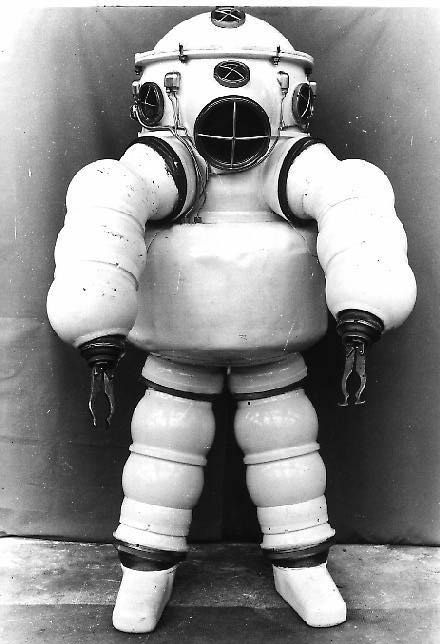

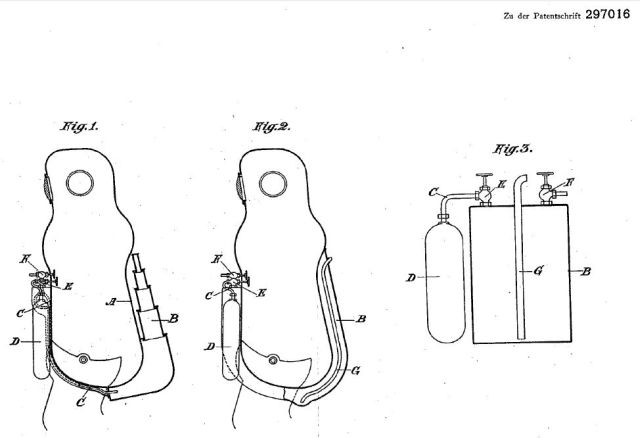

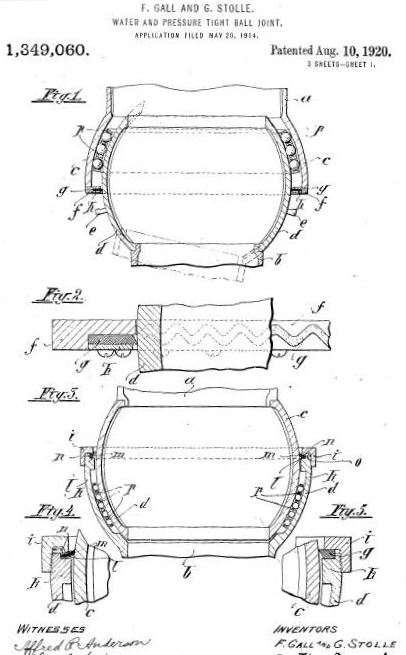

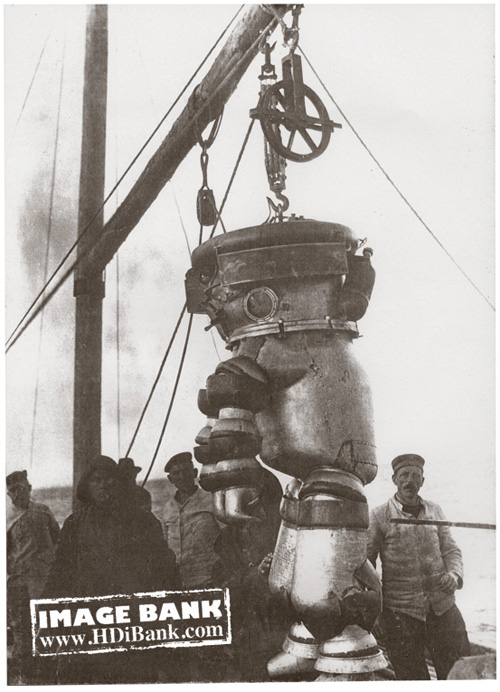
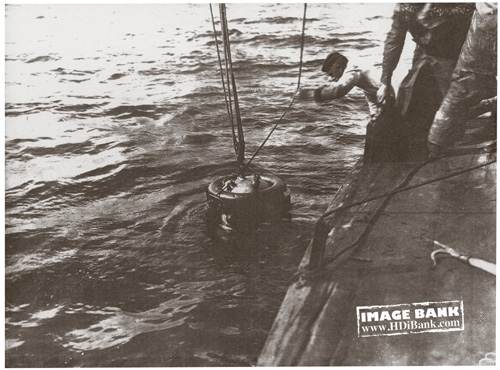
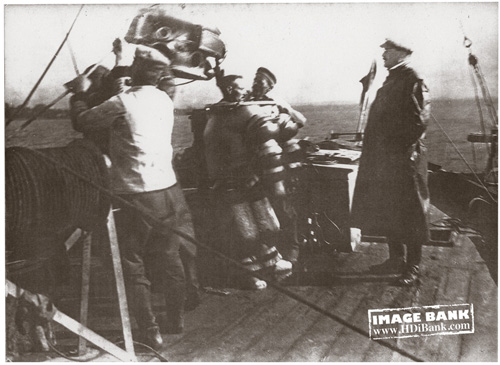
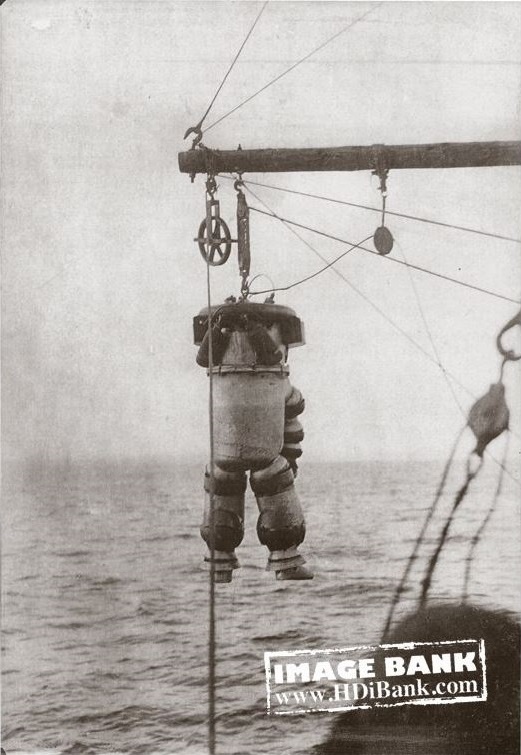
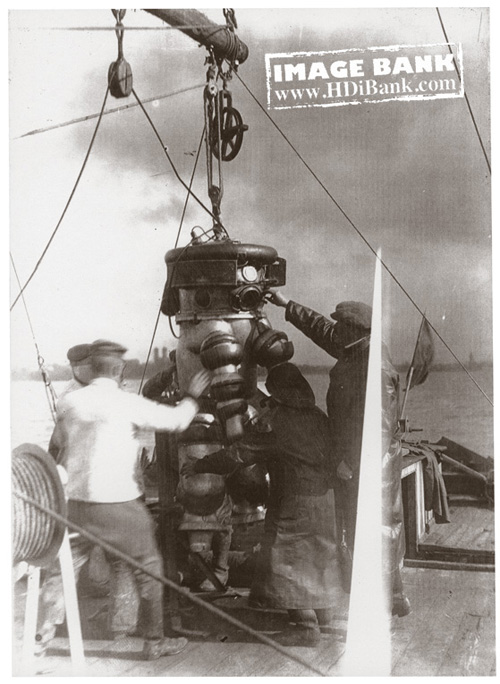
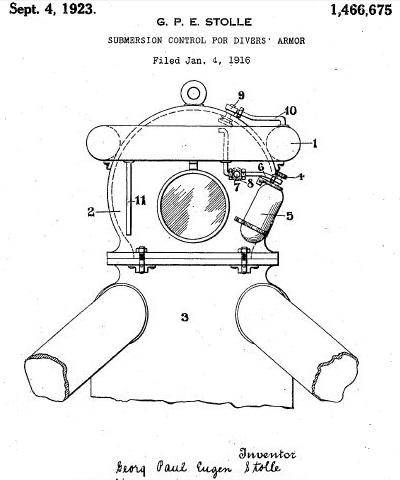
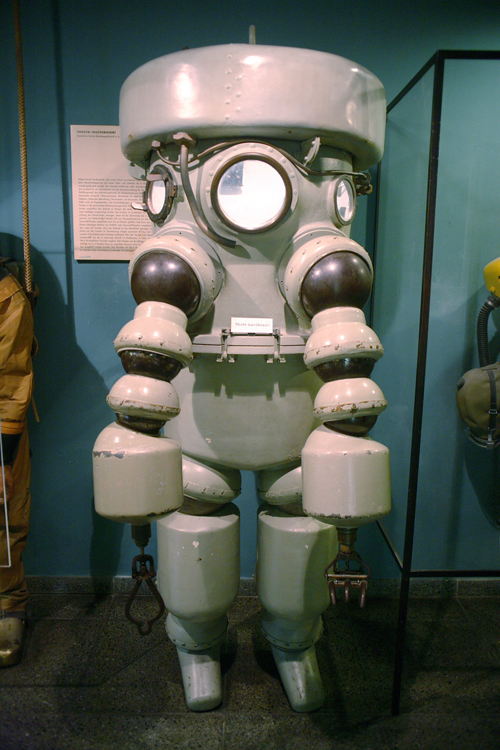
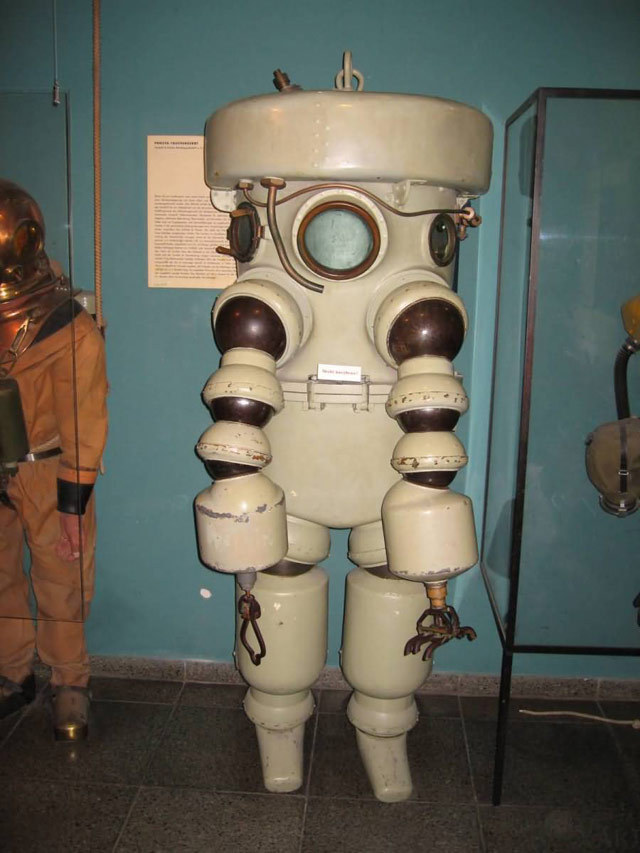
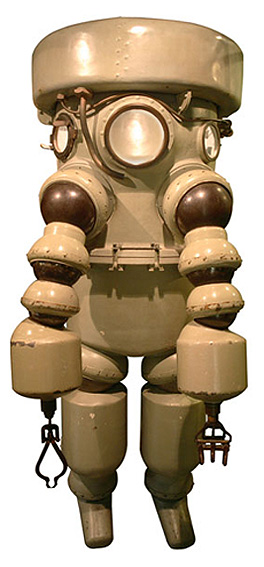
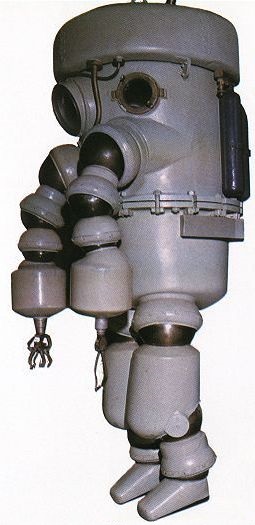
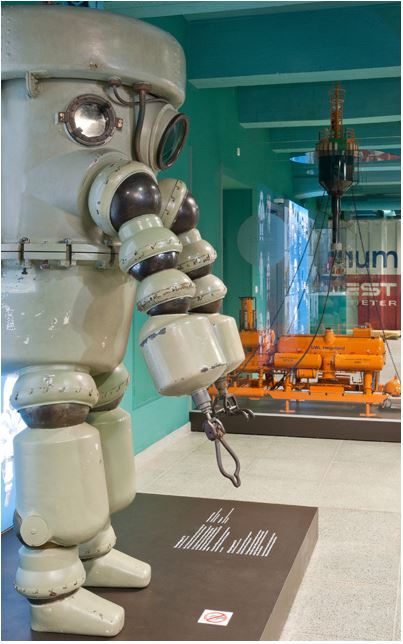

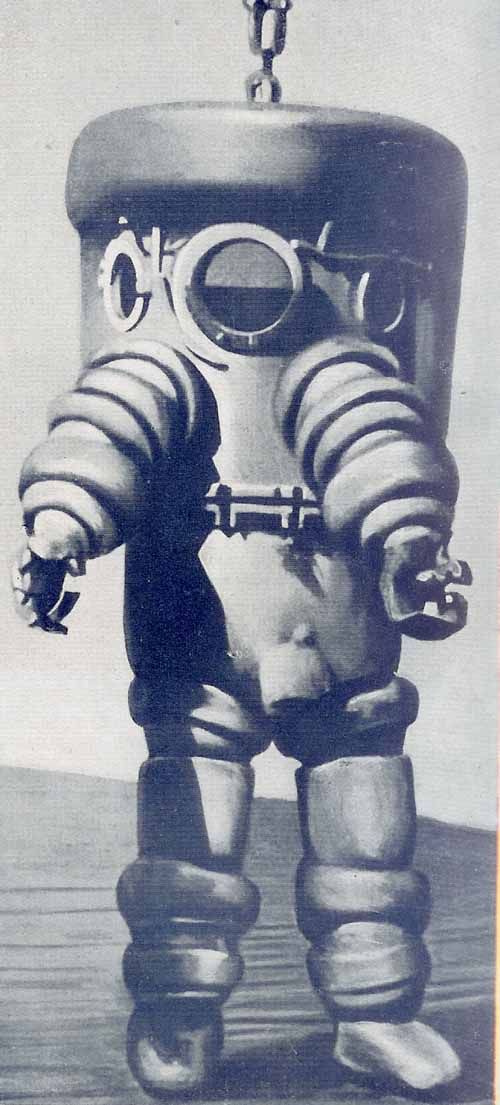
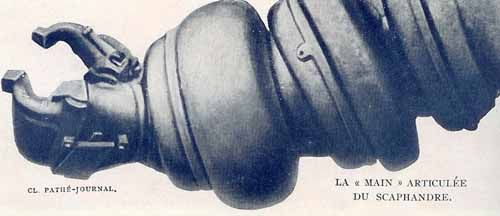
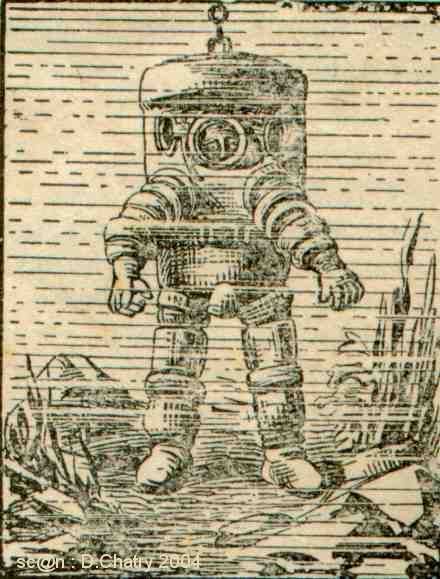
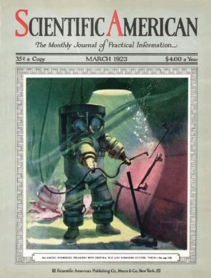
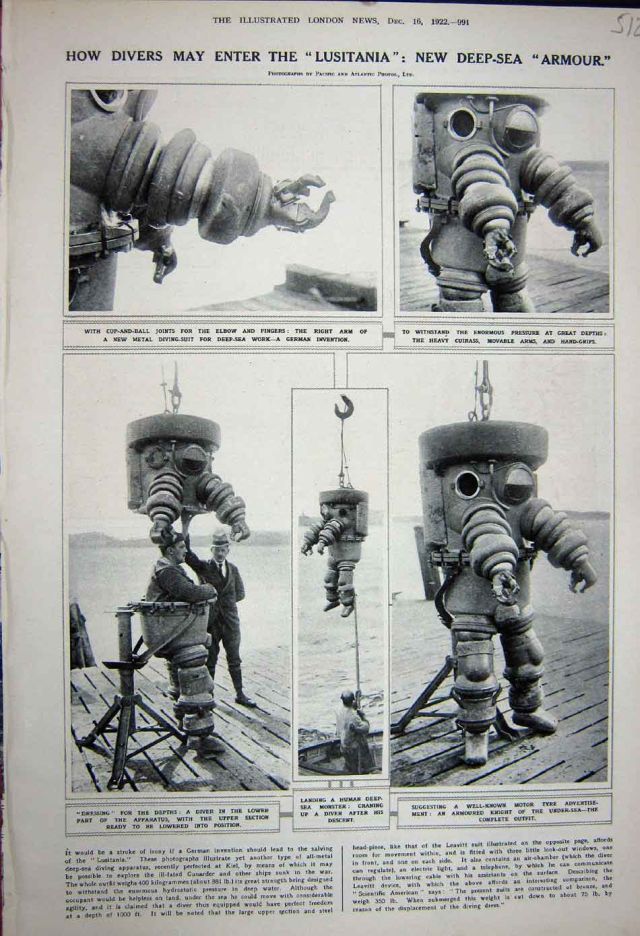
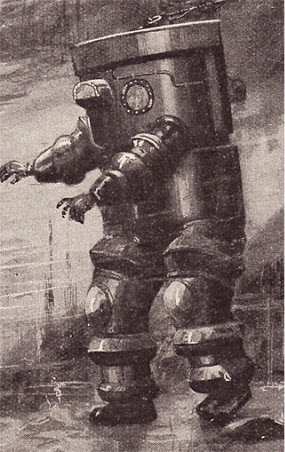
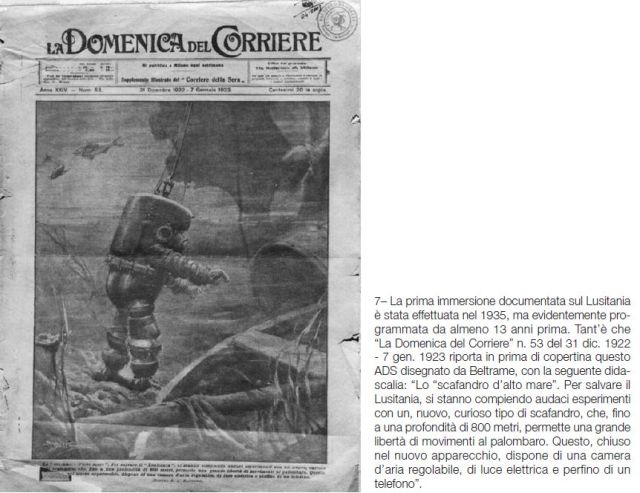
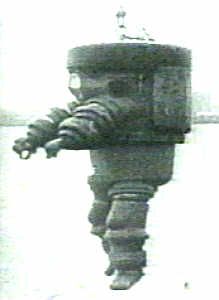
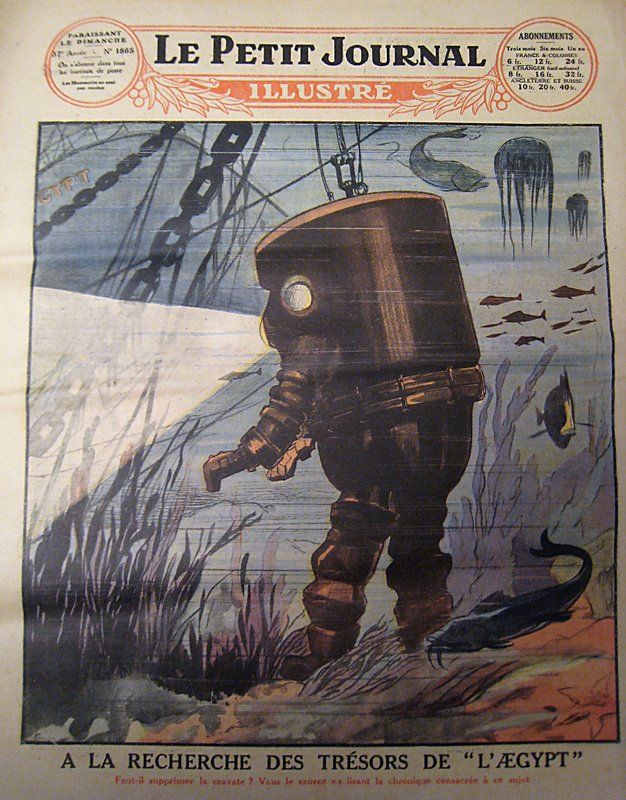



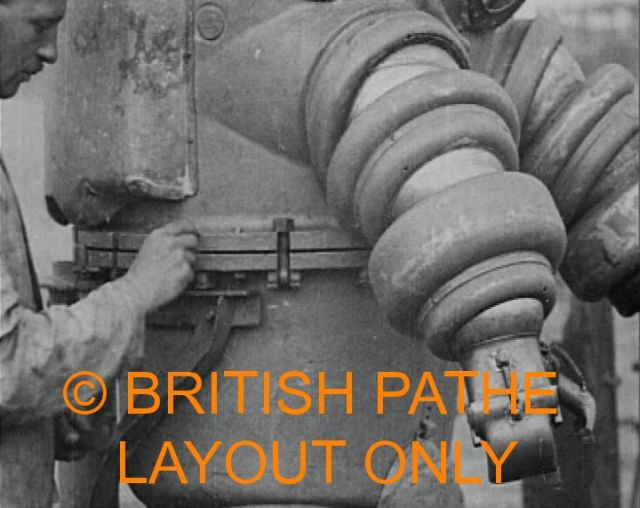

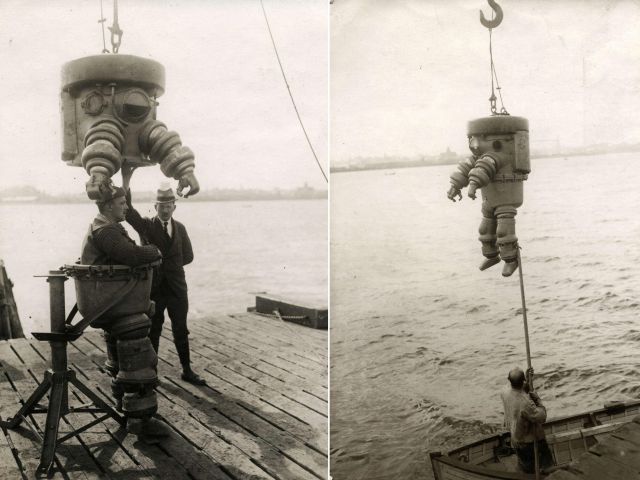
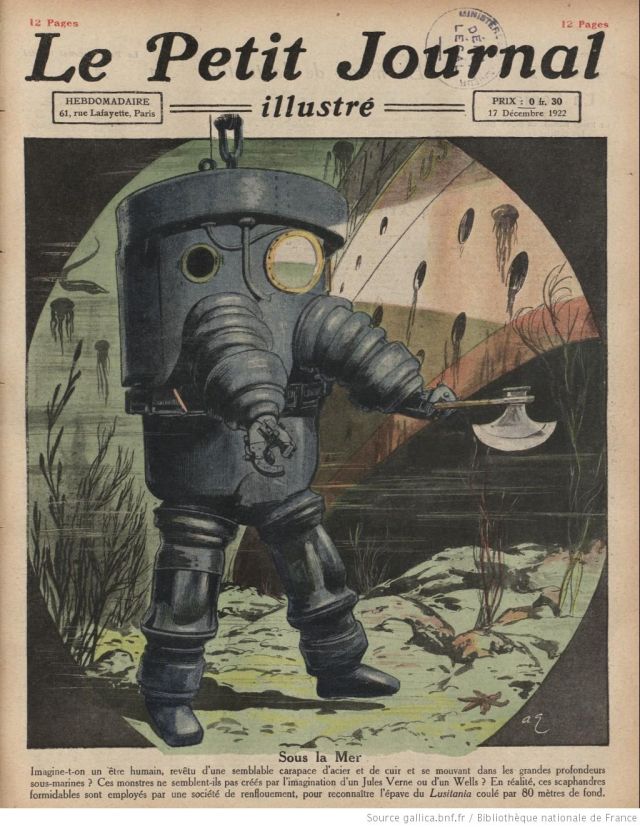
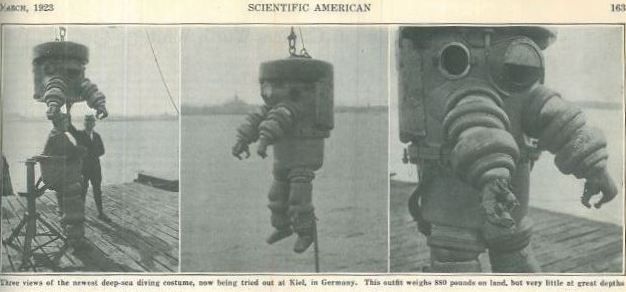
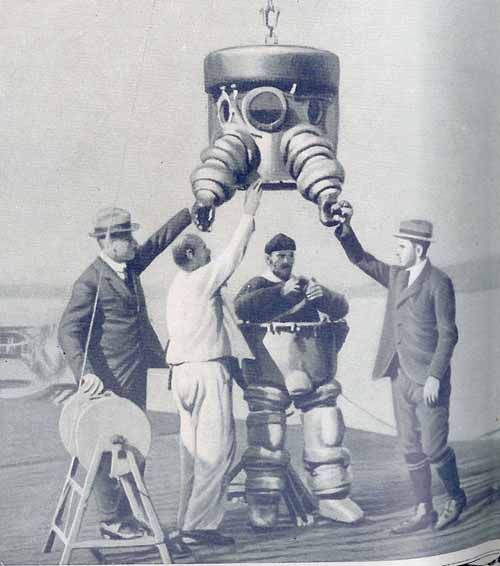
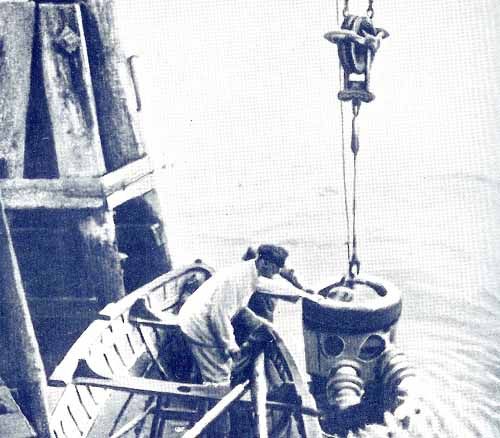
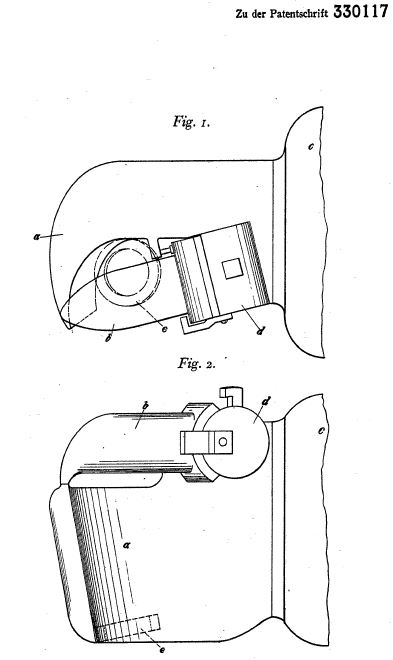

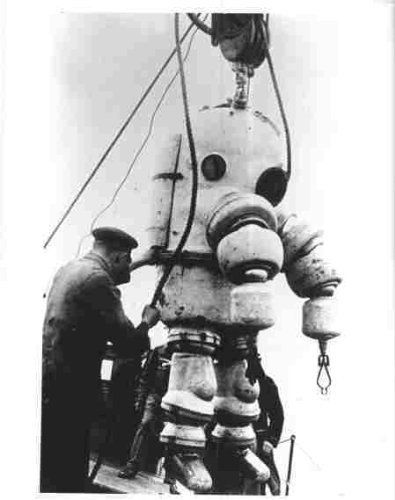

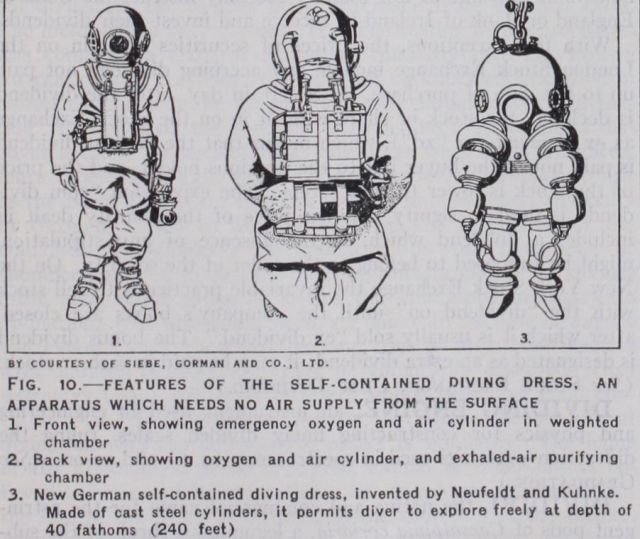
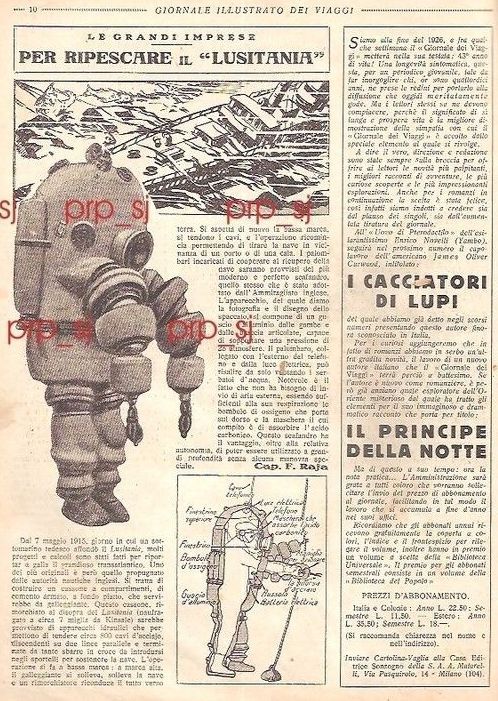



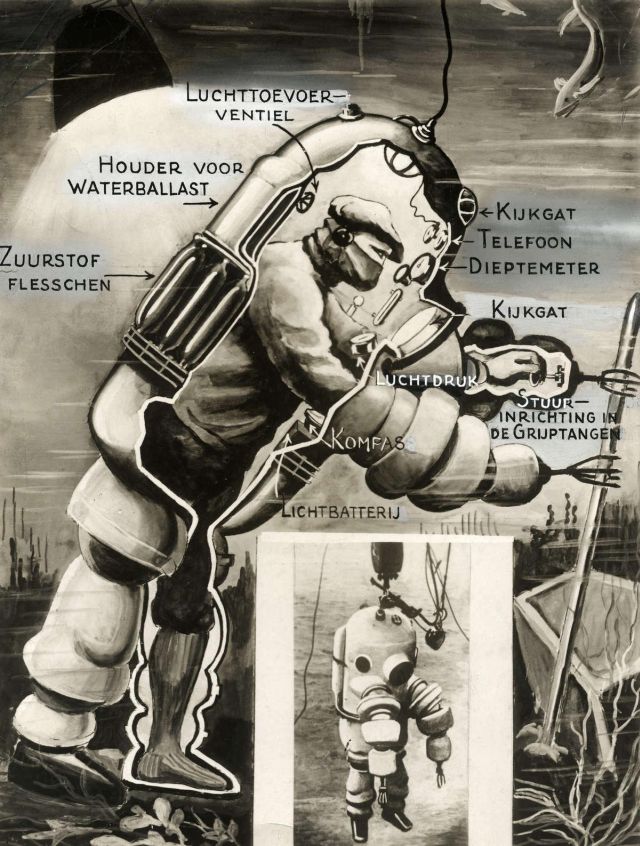
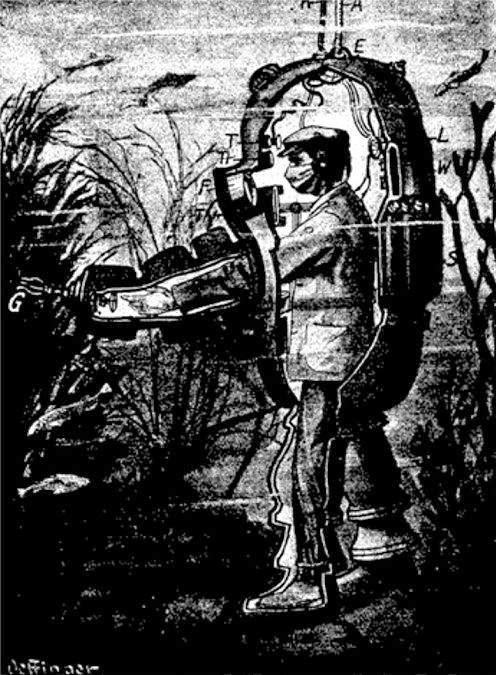
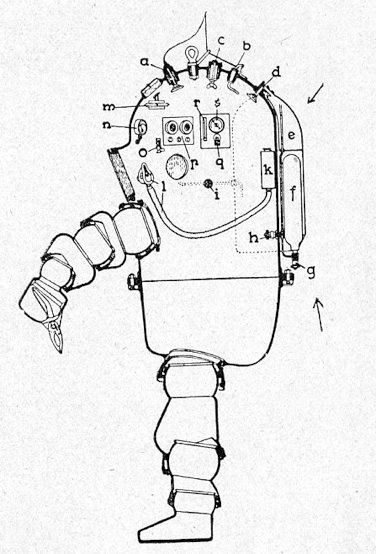

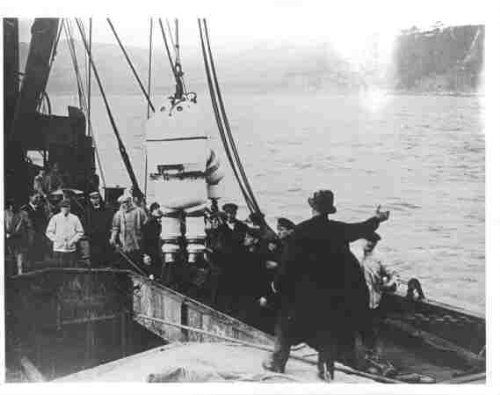
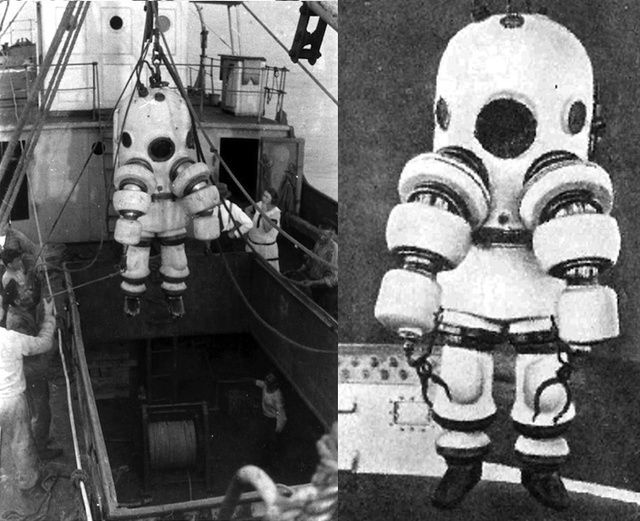
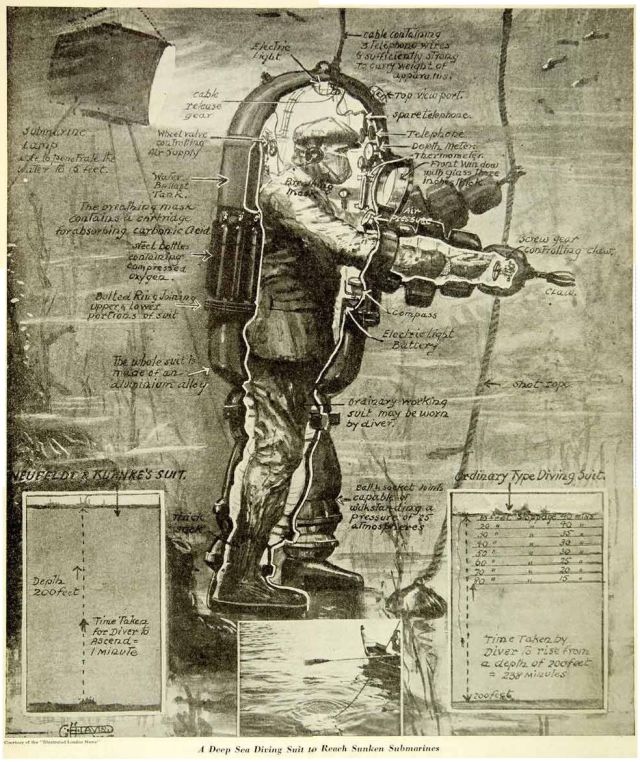
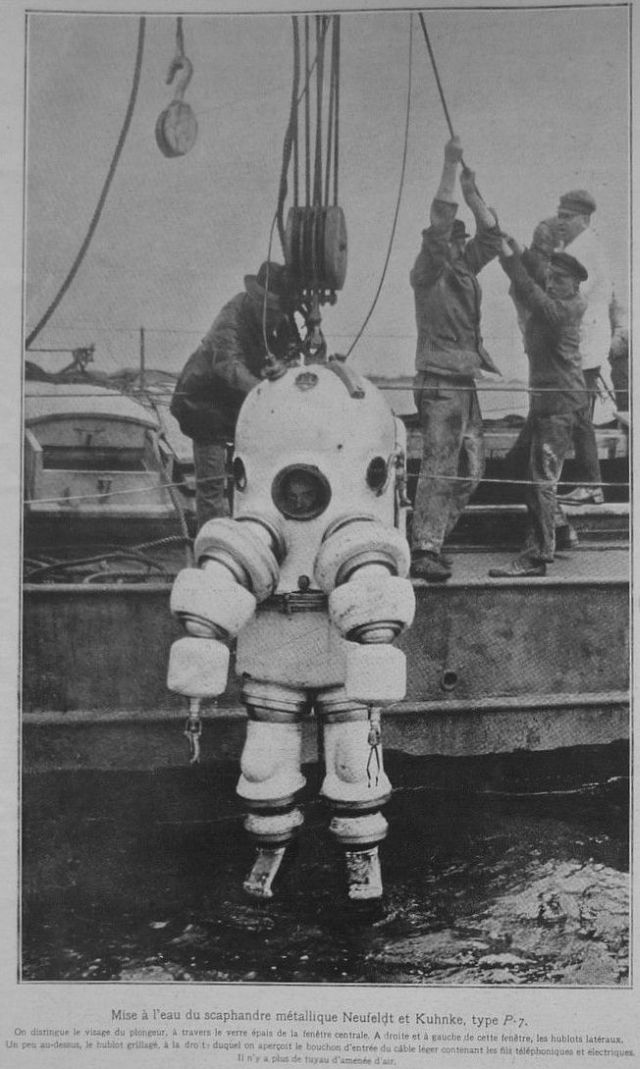



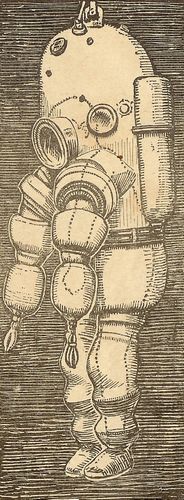
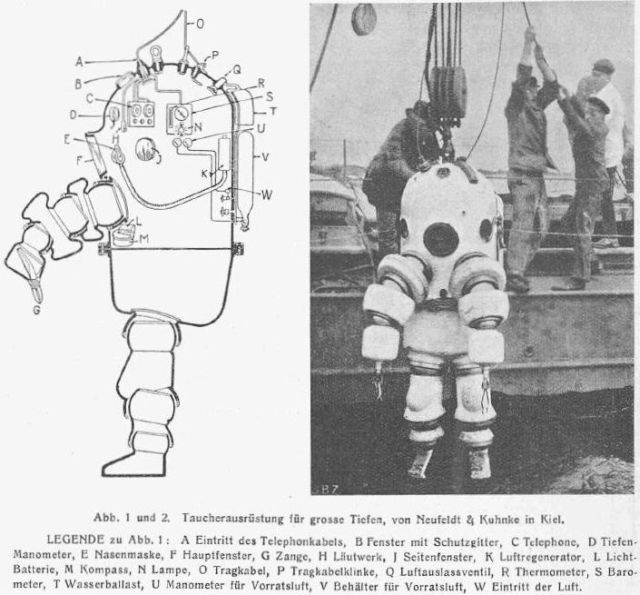
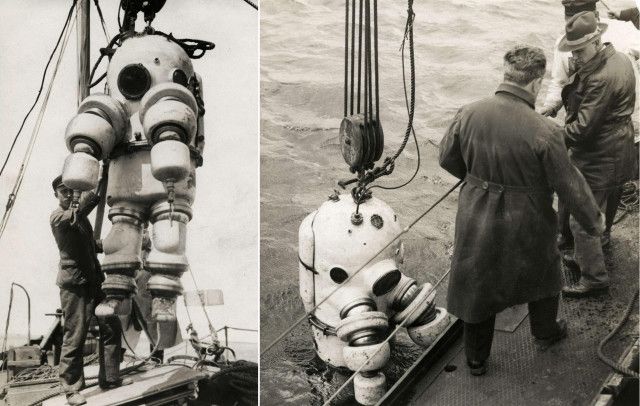
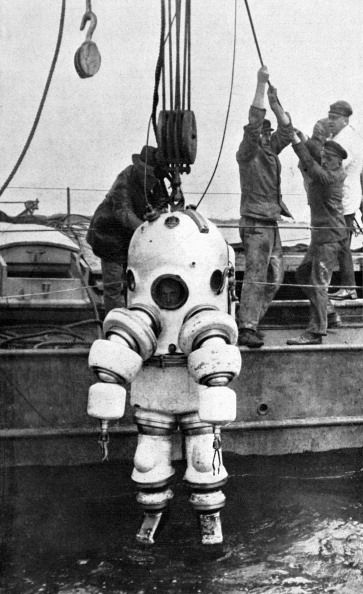
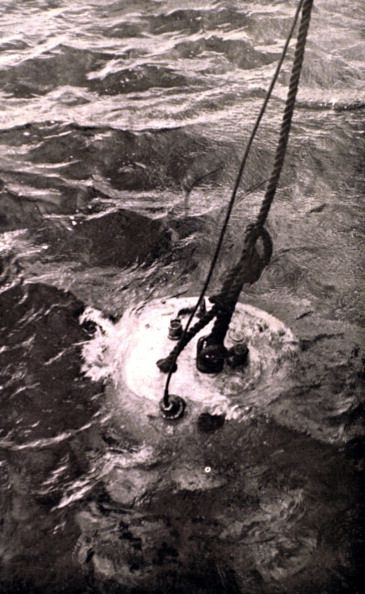
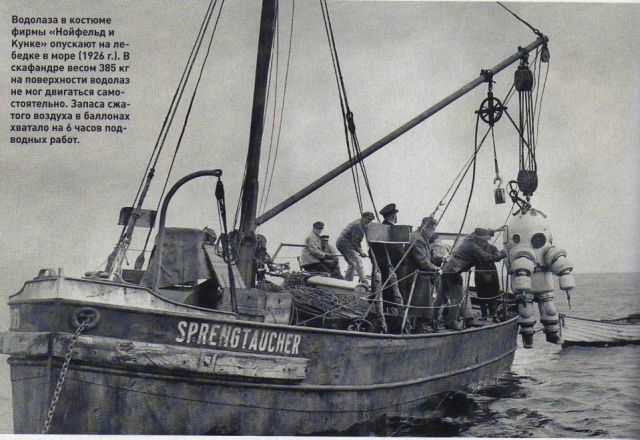
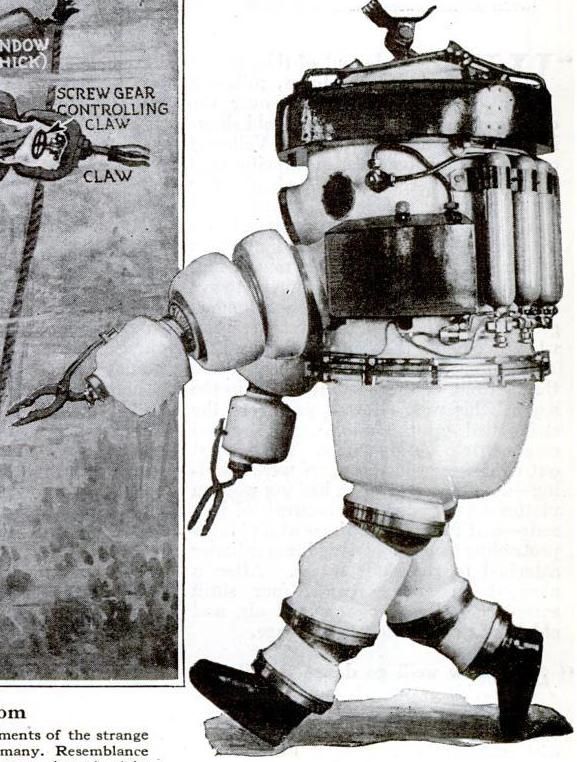
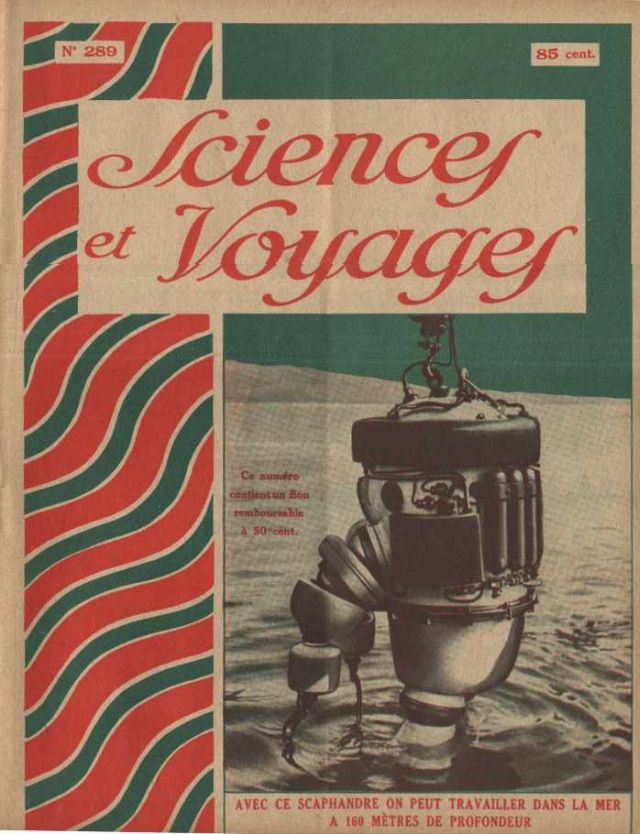
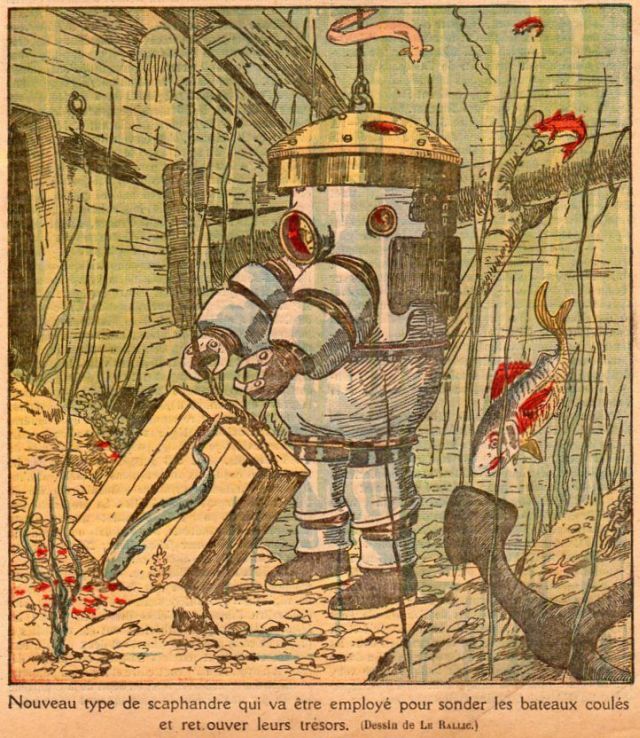
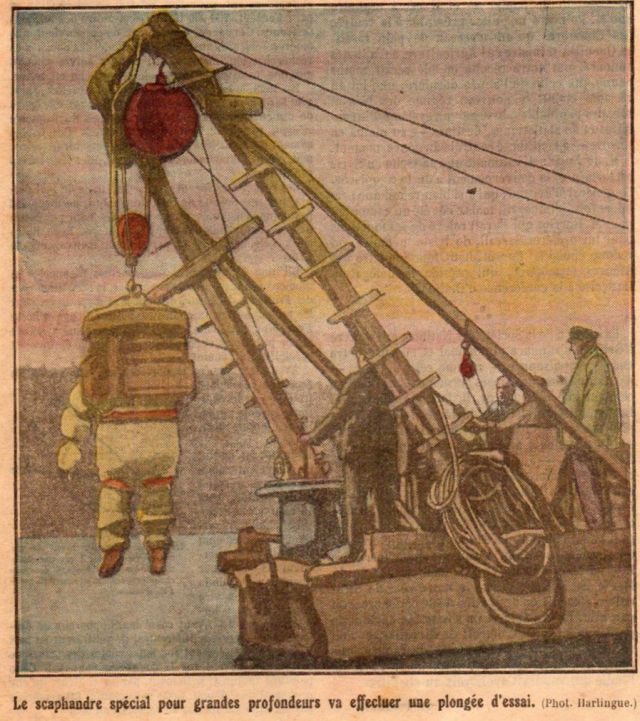


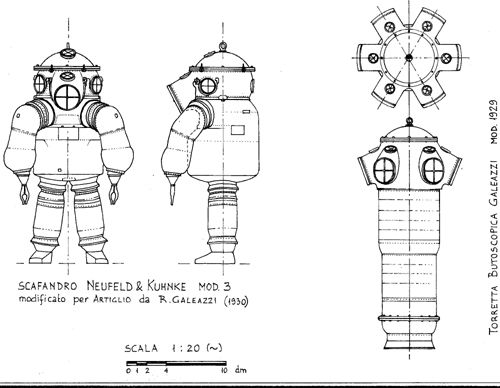
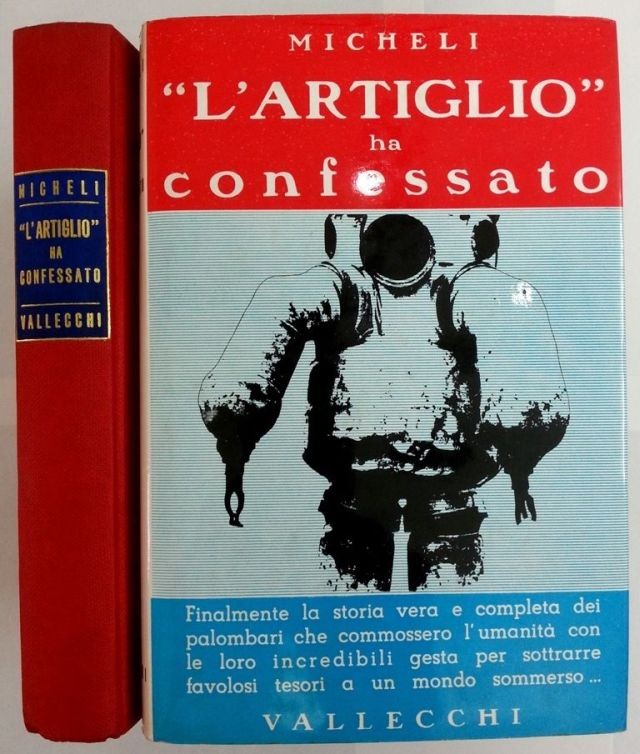
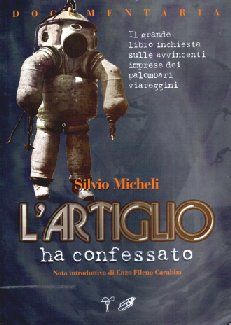
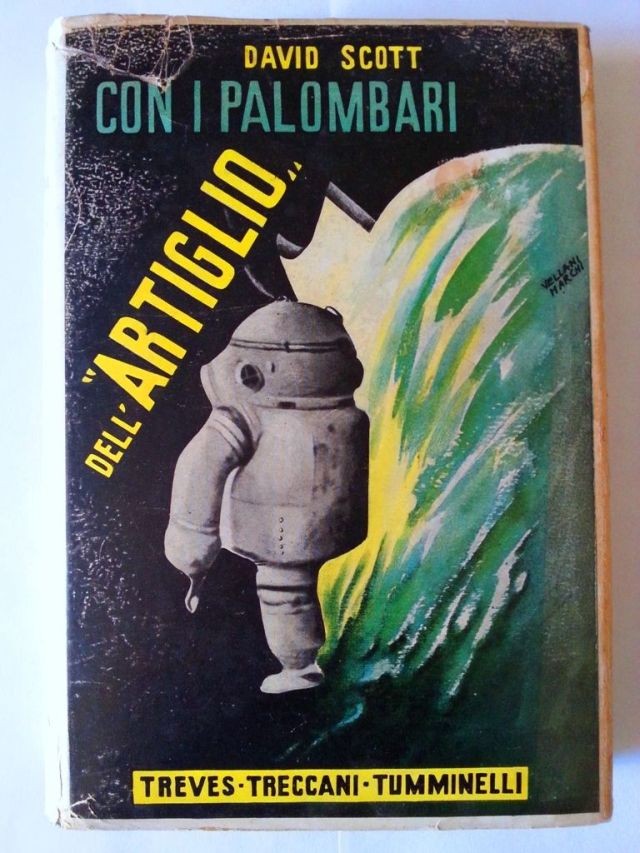

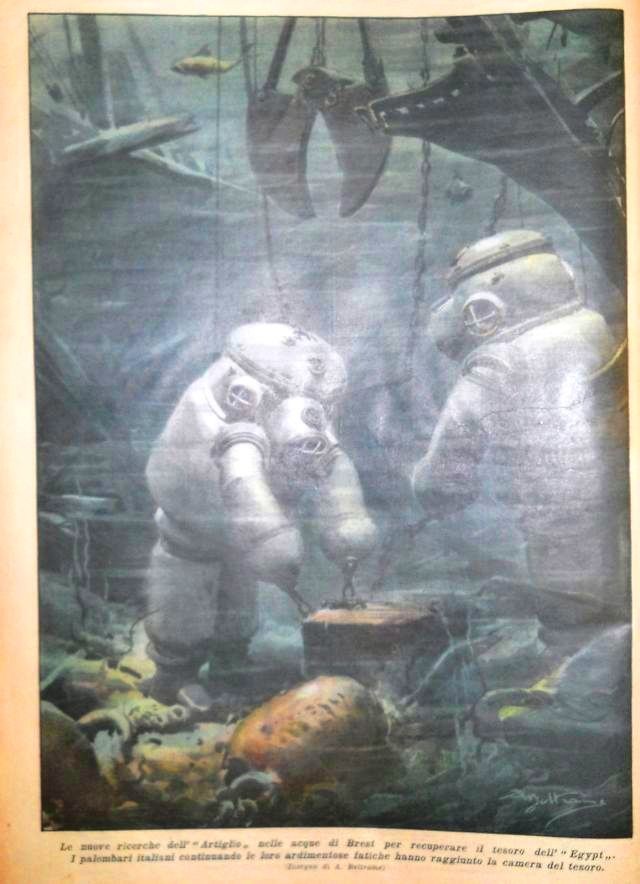
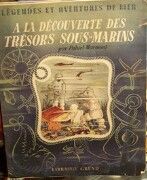
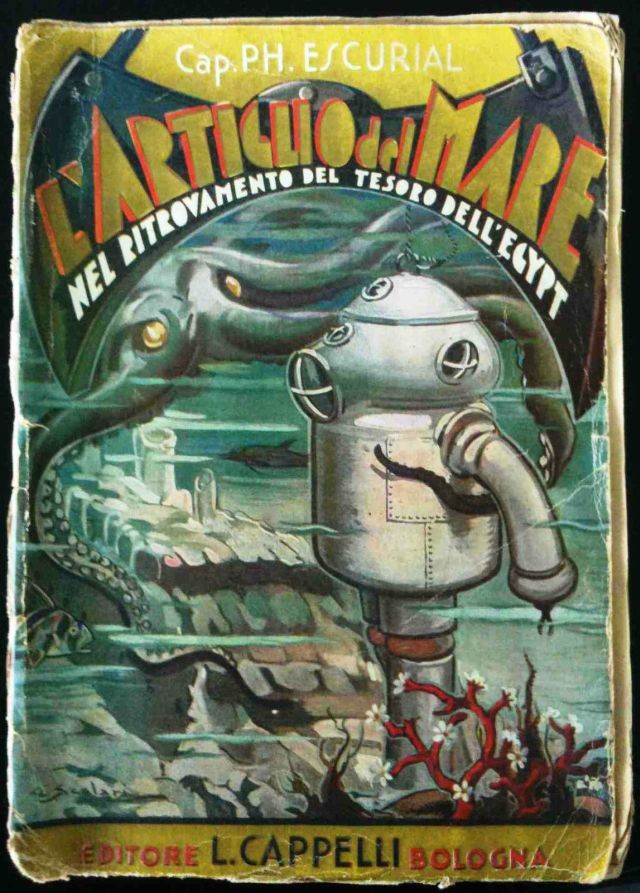
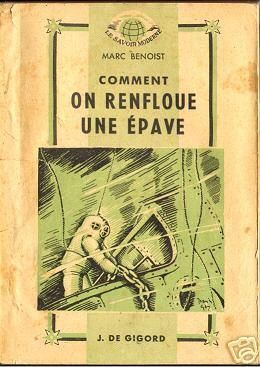
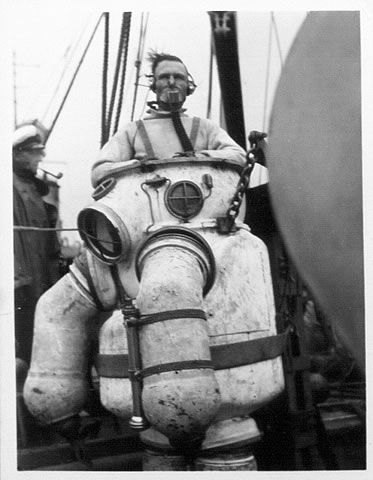


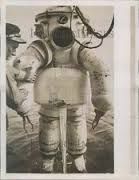

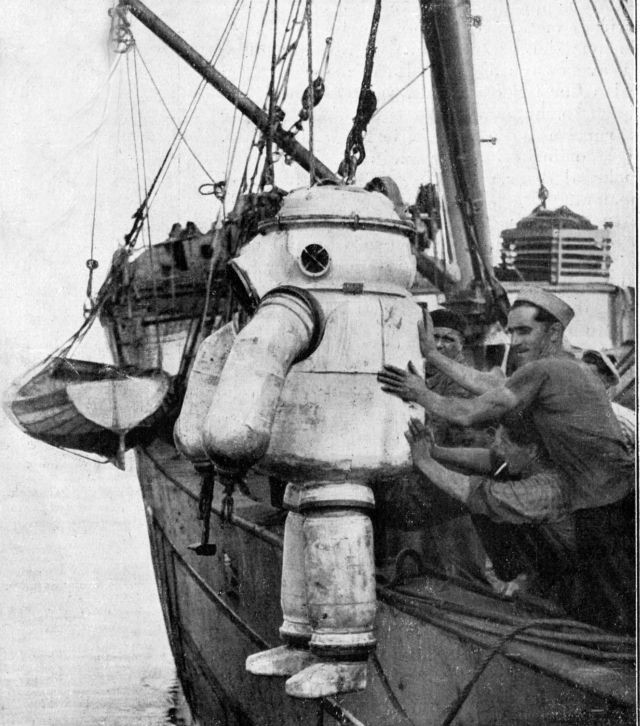
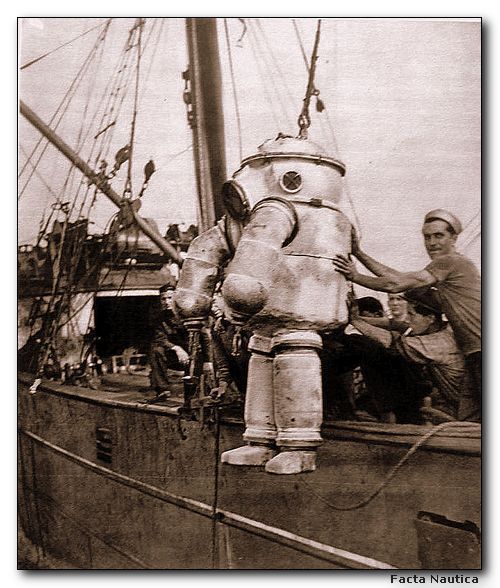
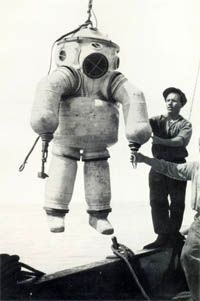
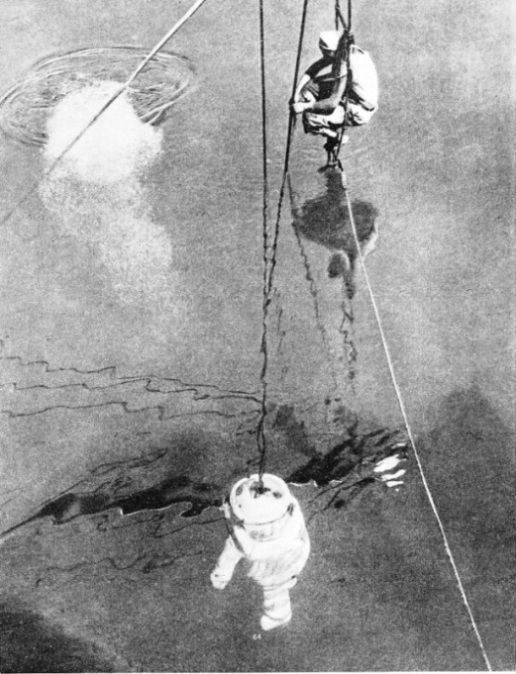


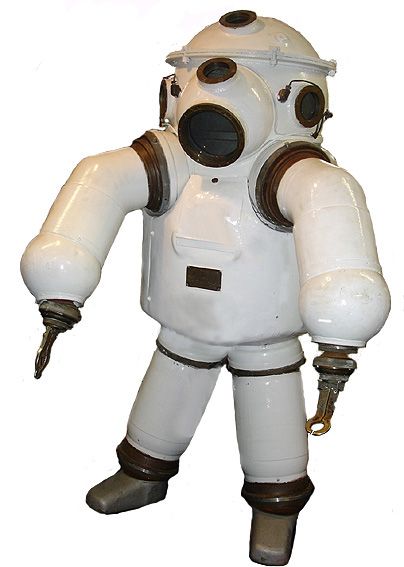


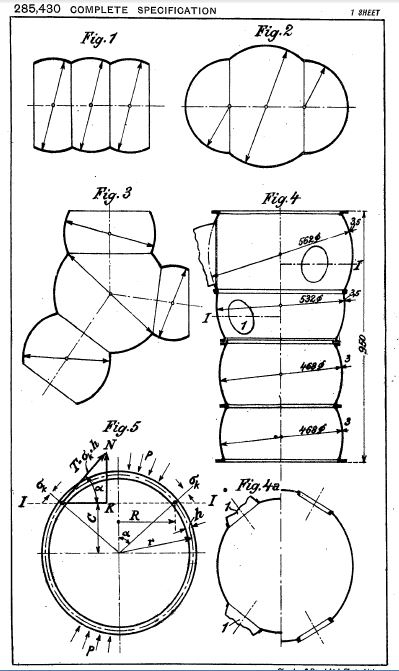

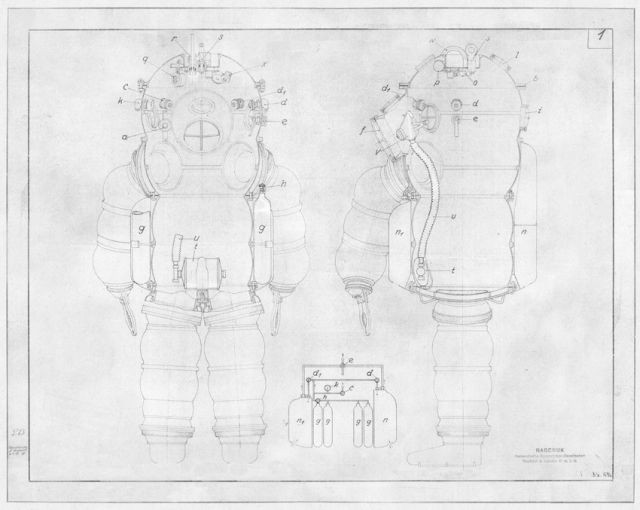
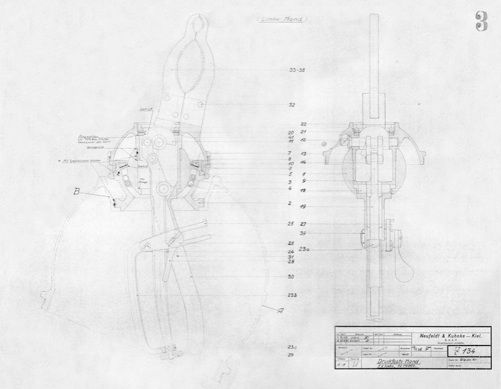
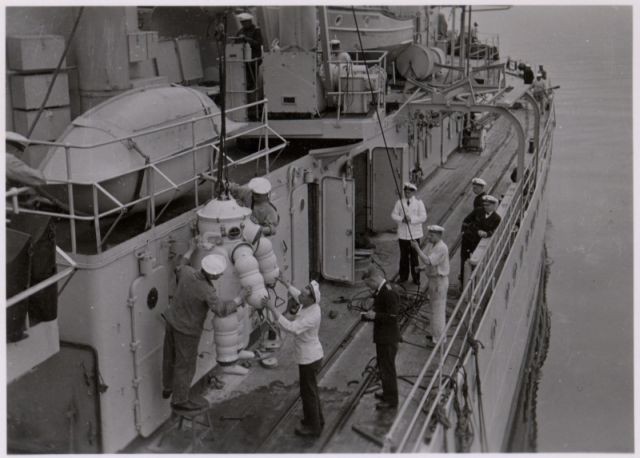
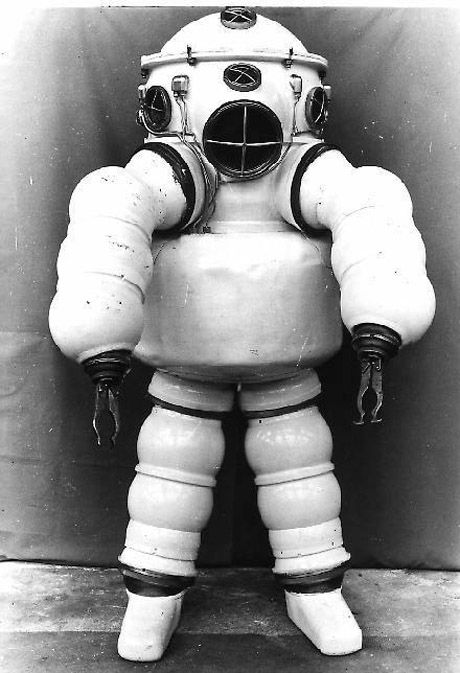


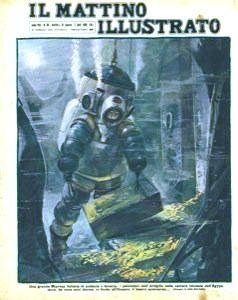
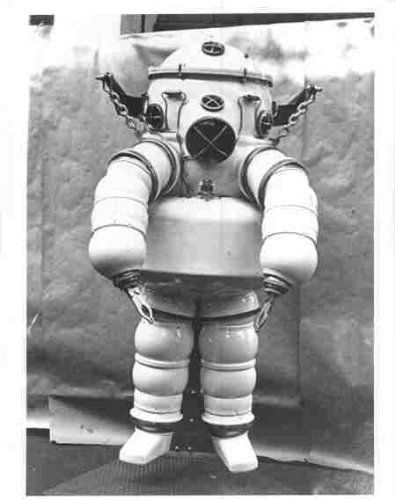

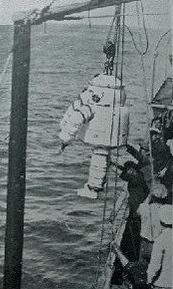

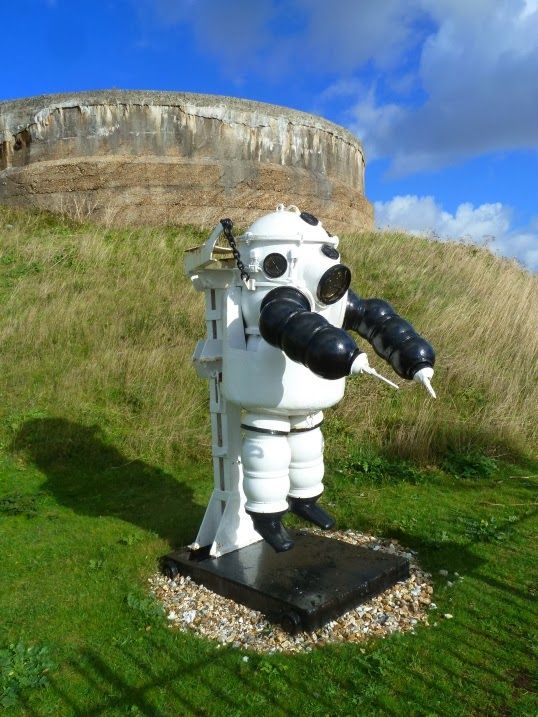


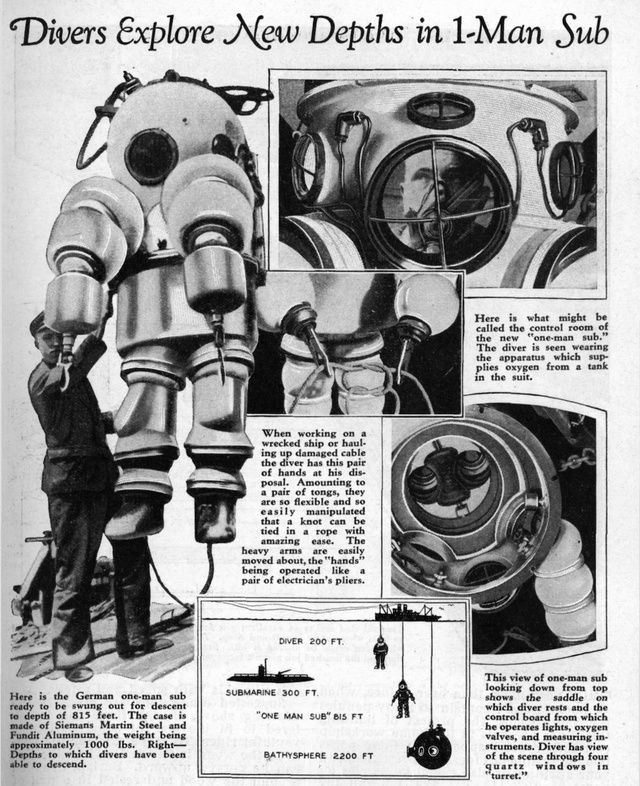
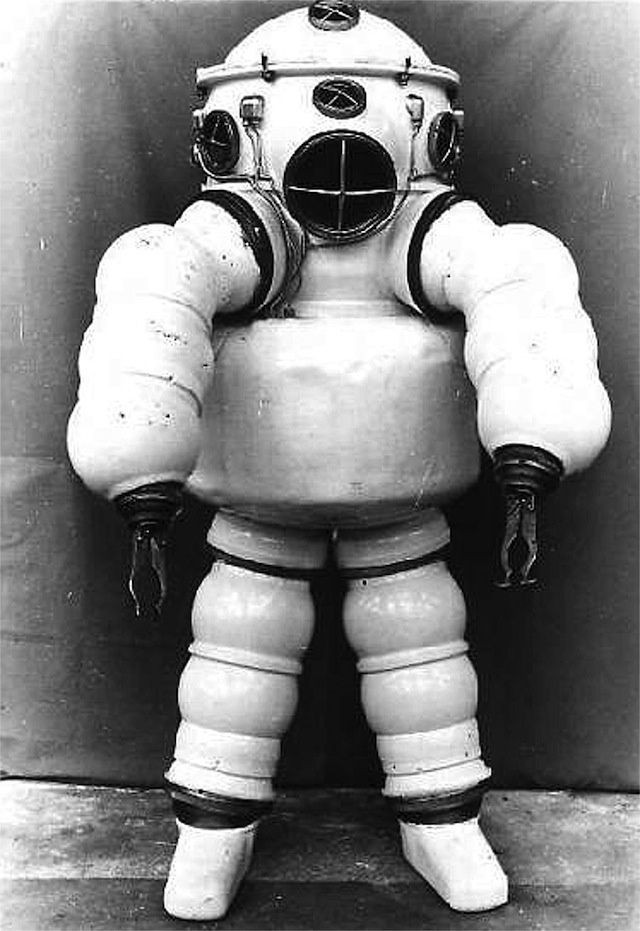
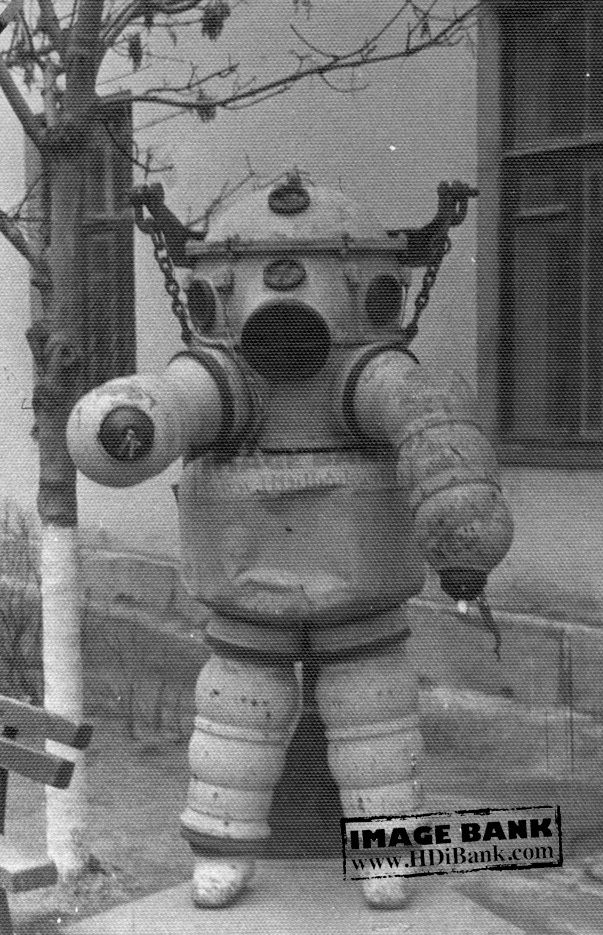
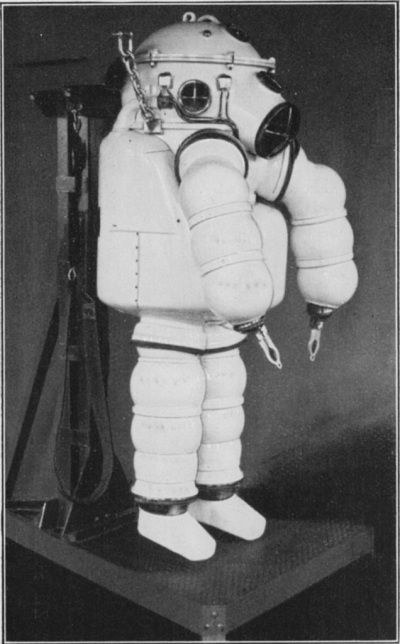


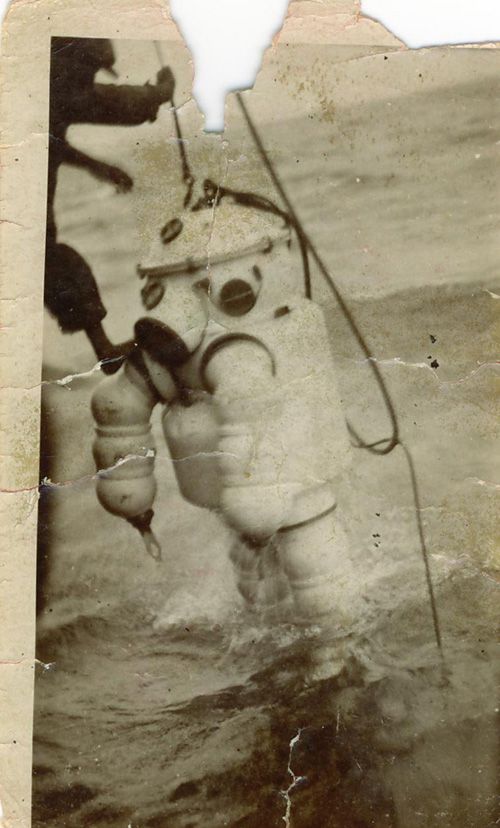
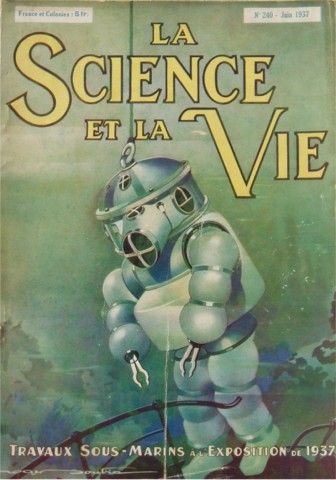

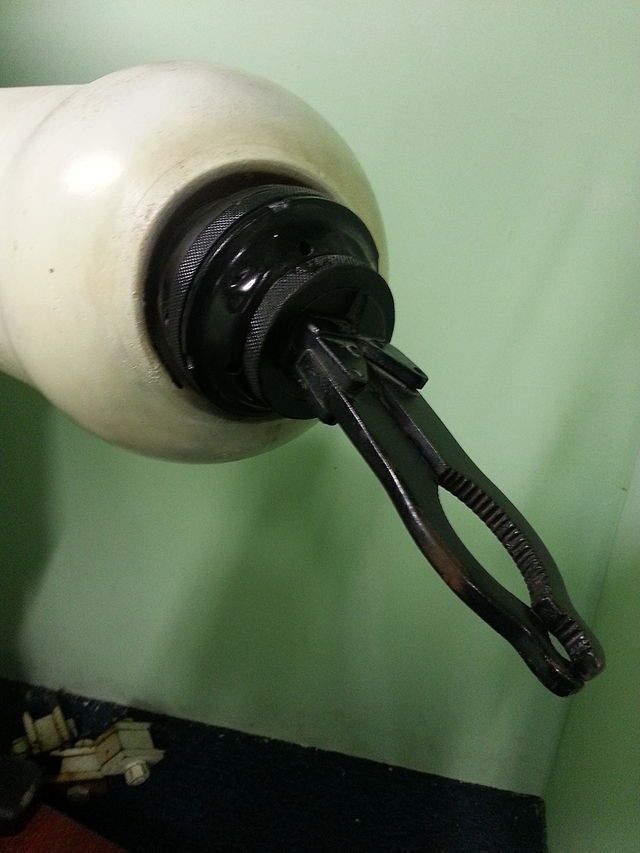
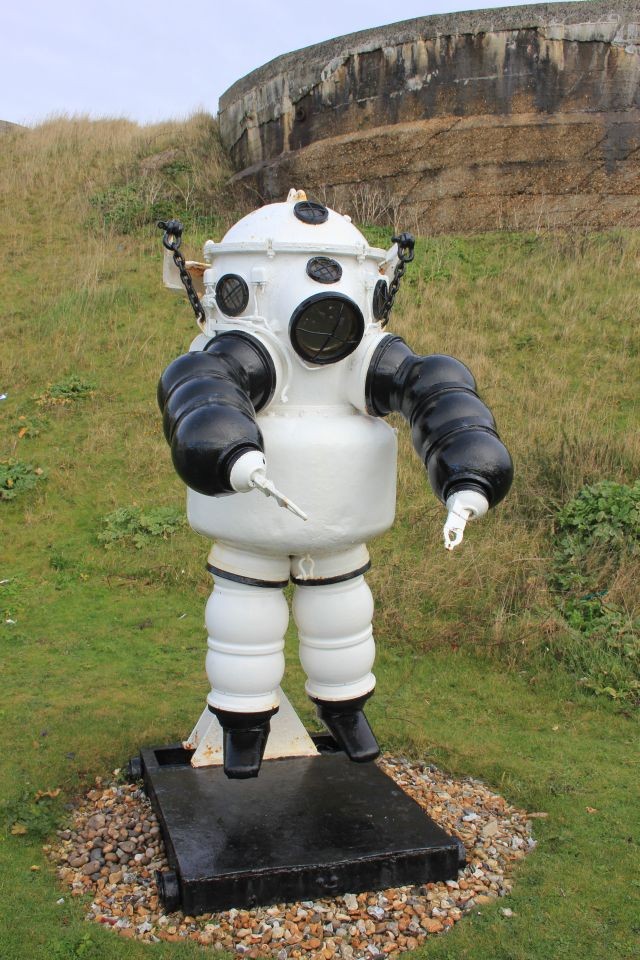

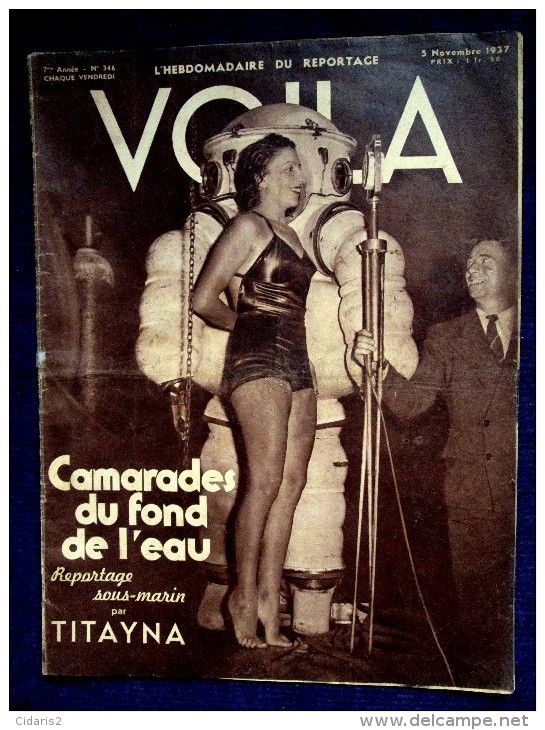
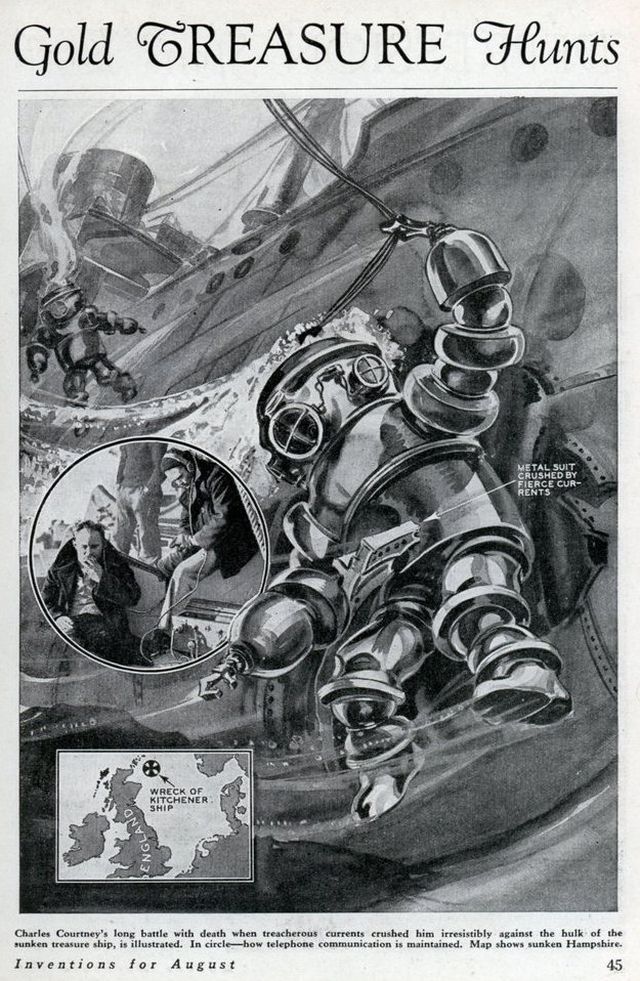

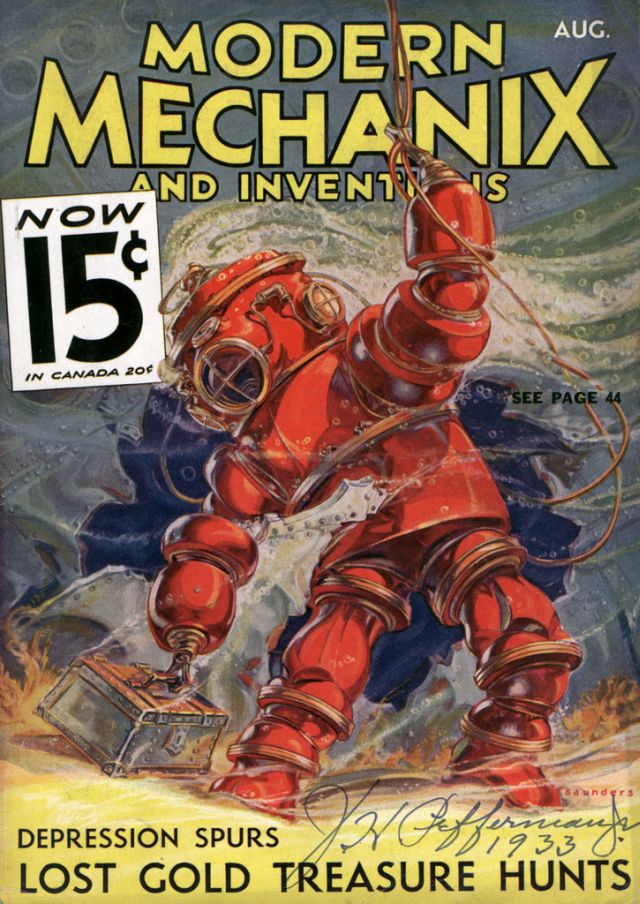
Kudos to a very informative website. I've learned a great deal about the history of the deep sea dive suit. It's amazing to think about the technology that we had in the past compared to what we can achieve in the future.